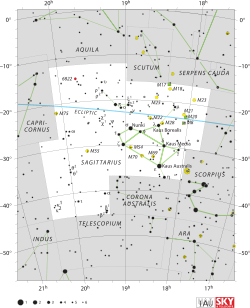63 Ophiuchi

The location of 63 Ophiuchi (circled) in the constellation Sagittarius | |
| Observation data Epoch J2000.0 Equinox J2000.0 (ICRS) | |
|---|---|
| Constellation | Sagittarius |
| Right ascension | 17h 54m 54.04380s[1] |
| Declination | −24° 53′ 13.5413″[1] |
| Apparent magnitude (V) | 6.18[2] |
| Characteristics | |
| Spectral type | O8III[2] |
| U−B color index | –0.89[3] |
| B−V color index | +0.04[3] |
| Astrometry | |
| Radial velocity (Rv) | –11[4] km/s |
| Proper motion (μ) | RA: 1.66[1] mas/yr Dec.: –2.63[1] mas/yr |
| Parallax (π) | −0.77 ± 0.40[2] mas |
| Distance | approx. −4,000 ly (approx. −1,300 pc) |
| Details | |
| Rotational velocity (v sin i) | 86[5] km/s |
| Other designations | |
63 Ophiuchi is an O-type giant star in the constellation Sagittarius, despite its name. During a 2009 survey for companions of massive stars, it was observed using speckle interferometry but no companion was found.[6] Uncertain negative parallax measurements of –0.77 ± 0.40 mas[2] suggest that this extremely luminous star may be located about 4000 light-years away. An estimate of the distance based on the strength of the Ca II line yields a more modest value of 2,605 ly (799 pc).[7] The star lies only 0.3° north of the galactic plane.[2]
In 1983, astronomers from the Sternberg Astronomical Institute in Moscow, Russia identified a faint, shell-shaped nebula surrounding the star that was being excited by the star's energy. Named Sharpless 22, this ring-shaped nebula has a double-shell structure with an inner envelope spanning 45–50′ (9–18 pc), surrounded by a diffuse envelope some 65–80′ (14–29 pc) across. At an estimated mass loss rate of (6–8) × 10–6 M☉/yr, it would take the star about (1–5) × 105 years to produce such a nebula from the outflow of its stellar wind.[8]
See also
References
- ↑ 1.0 1.1 1.2 1.3 van Leeuwen, F. (November 2007), "Validation of the new Hipparcos reduction", Astronomy and Astrophysics 474 (2): 653–664, arXiv:0708.1752, Bibcode:2007A&A...474..653V, doi:10.1051/0004-6361:20078357
- ↑ 2.0 2.1 2.2 2.3 2.4 2.5 "63 Oph -- Star", SIMBAD (Centre de Données astronomiques de Strasbourg), retrieved 2011-12-01
- ↑ 3.0 3.1 Schild, R. E.; Garrison, R. F.; Hiltner, W. A. (April 1983), "UBV photometry for southern OB stars", Astrophysical Journal Supplement Series 51: 321–336, Bibcode:1983ApJS...51..321S, doi:10.1086/190852
- ↑ Wilson, Ralph Elmer (1953), General catalogue of stellar radial velocities, Carnegie Institution of Washington, Bibcode:[http://adsabs.harvard.edu/abs/1953QB901.W495..... 1953QB901.W495.....]
- ↑ Hubrig, S. et al. (November 2008), "Magnetic field measurements of O stars with FORS 1 at the VLT", Astronomy and Astrophysics 490 (2): 793–800, arXiv:0808.2039, Bibcode:2008A&A...490..793H, doi:10.1051/0004-6361:200810171
- ↑ Mason, Brian D. et al. (February 2009), "The High Angular Resolution Multiplicity of Massive Stars", The Astronomical Journal 137 (2): 3358–3377, arXiv:0811.0492, Bibcode:2009AJ....137.3358M, doi:10.1088/0004-6256/137/2/3358
- ↑ Megier, A. et al. (November 2009), "The interstellar Ca II distance scale", Astronomy and Astrophysics 507 (2): 833–840, Bibcode:2009A&A...507..833M, doi:10.1051/0004-6361/20079144
- ↑ Lozinskaya, T. A.; Larkina, V. V.; Putilina, E. V. (June 1983), "A New Search for Ring Nebulae around Of-Stars - SHARPLESS22", Soviet Astronomy Letters 9 (6): 344–345, Bibcode:1983SvAL....9..344L
| ||||||||||||||||||||||||||